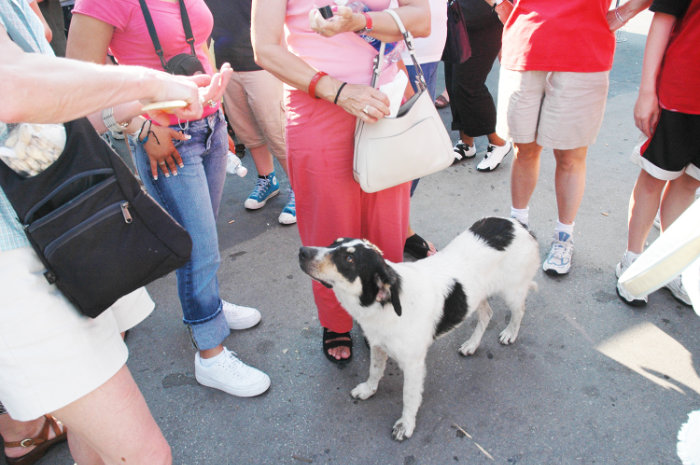I’ve had several opportunities to observe unowned “street dogs” in different habitats, from Indian reservations to beaches to foreign countries. Years ago I went on a school-organized trip with my son’s middle-school class to Italy; watching the famed stray dogs who live in the ruins of Pompeii was the highlight of my trip!
Almost everywhere there is a persistently high population of street dogs, “reservation dogs,” or “sato dogs,” there are organizations devoted to helping them, ranging from capture/vaccination/spay/neuter programs to adoption programs. And this is great, because the threats to the lives of stray dogs are many:
- Parvovirus and distemper kills many unvaccinated street dogs.
- Many suffer terribly from fleas and/or mange.
- Long-term suffering from ticks and tick-borne disease, and from giardia and/or coccidia may also shorten the dogs’ lives.
- If they haven’t been captured and spayed/neutered at some point, they will unavoidably add to the population of homeless dogs. Females may suffer during breeding season, unable to escape being bred by numerous males, and from birthing/feeding more puppies than her body can maintain. Males may suffer from fights brought on by the proximity of a female in season, and from wandering farther afield than they normally would, in search of the scent of a female in season.
- Being hit by cars is far too common.
- In rural areas, many stray dogs meet their ends as they hunt for food and end up getting shot by farmers or ranchers.
On the other hand, I sometimes consider that some of these free-roaming dogs may be happier than some owned dogs who have regular health care, food, and warmth. There are a great many owned dogs who suffer from the helplessness of being locked up in a tiny cage or crate, dependent on a human’s schedule to eliminate when they need to, or for meeting other basic needs. Many dogs are subjected to lives of relative emotional and mental poverty, spending huge chunks of each day in social isolation and deprivation.

“Street dogs” can satisfy their curiosity about anything that catches their eyes or ears, investigating at will. They can exercise when they want, as much as they want. They usually develop relationships with other dogs, staying in a loose “family” group with other dogs they trust.
But it’s undeniable that their lives tend to be short, much shorter than owned dogs. There are just so many hazards.
In recent years, a great many groups have begun to import street dogs from other countries into the U.S., in hopes of finding adopters here. While this undoubtedly saves lives, I can’t tell you how many reports I’ve heard from trainers who have been called upon to help the families who have adopted former street dogs from Puerto Rico or Russia, or brought home by soft-hearted soldiers in the Middle East. Sometimes these dogs have a really rough time adapting to the typical lifestyle of an owned dog in America: being walked on leash everywhere, having no freedom to roam, perhaps being an only dog, and spending a lot of time alone.
There is no way to know what’s best for any individual. But I must say, when a stray adolescent dog on an Indian reservation recently approached me, all of the above went through my mind. If I had been closer to home or had any room in my car, I would have been seriously tempted to “rescue” him – but what if he already had a loving family, and was merely given the freedom to wander?







I adopted two satos from Puerto Rico via The Sato Project, an amazing organization. One of my dogs was intentionally run over, dragged, and left for dead on Dead Dog Beach in Yabucoa. The Sato Project rescued, rehabilitated, and , through numerous surgeries, spent a year bringing her back to health. My other dog was dumped with her three young puppies , also on Dead Dog Beach. These wonderful dogs would have had no life had the Sato Project not rescued them and invested in their future. I am forever grateful that this organization, and others like it, exist. Please follow them. Last week they pulled 80 dogs from a PR kill shelter with a 98% euthanasia rate. Once quarantined, fully vetted, & spayed/neutered they will be flown to NY to loving new families.
Fabulous rescue organization.
There is also PRoud Rescuers of Puerto Rico that work with the Satos Project. They do awesome work.
I know the article mentions the negative sides of dogs living in the streets. I however have still the feeling this is depicting the issue a little one-sided. The quality of life of the dogs (and cats) in the streets is even less, many suffer from TVT, a totally curable cancer, the anemia they have will slowly deprive them of oxygen and parasites like heartworm will give them a slow death if they make it into adulthood. This is especially true for countries with warmer climates. I am not talking about rescuing all of them and send them off, but we need to focus on spay and neuter clinics, education about responsible ownership (as yes, many have “owners”), and community outreach programms to give the community animals some dignity and medical treatment while they live in the streets.
I visited Korea several years ago and rode in a bus along the demilitarized zone (DMZ). This strip of land between South and North Korea is is covered in tall brush and wild grasses and “protected” by land mines to keep people from crossing the border. It This same land is the habitat of healthy-looking mostly-white dogs with prick ears and weigh approximately 40-50 lb. They look like smallish sled dogs to this Husky breeder. They eat mostly rabbits and rats, according to one of the South Koreans with whom I spoke. The dogs romp and play without much of a care in the world. Somehow, they manage to stay away from all of the land mines, that, I am told, are sensitive enough to explode if a 40 lb. animal bounces on them. I am not sure how they do that!
They smell the explosives.
They likely smell the explosives and are taught by parents and older dogs how to avoid the mines. If a giant rat can smell a landmine, so can a dog.
In the more advanced nations, the acceptable treatment of our pet dogs has undergone a massive shift from when I had my first dog. When I was a child in the 50s and 60s, it was acceptable to have a dog chained up in your back yard and they were fed whatever dog food was cheapest! Realize our dogs were not neglected. They had shelters filled with straw and were monitored for water. And once we could afford to fence in the yard, they were left loose to run and play whenever we kids were outside.
But they certainly didn’t have the full lives that our modern in-house dogs live. The very fact that we are talking about getting involved in helping street dogs in other countries makes me proud to be part of a more humane human race. May we continue to advance in our attitudes and empathy for all of the creatures that share our world!
The late Ray Coppinger examines many of the issues Nancy discusses above in his books. His theories are not without controversy and they make fasinating reading.
I have been rescuing dogs from a breed rescue for 20 years. They are wonderful and come from all backgrounds. Most have been to Hell and back, abused, tortured, chained outdoors for years. Occasionally I have one that has been loved and the owner died. They are the best although one was too old and traumatized from the journey here that she died within two weeks. Most have regained some trust of humans.
One problem that has not been mentioned is that when you “rescue” dogs from all corners of the world they bring diseases for which we have no cure, vaccine or knowledge of how to treat it. These dogs transmit that disease to others they meet and now we have a New Disease. I am not suggesting that rescuing these street dogs from other countries should totally stop. Carefully assess the life of the dogs somewhere else before you bring it here. Most “street” dogs from the indigenous areas have made wonderful pets but there are others that have perfectly happy lives living by their wits in packs with friends that have the ability to hunt of scavenge for food. At least they are considered “local” but we have far too many unwanted dogs here that end up killed in shelters, by cars, by poison, in dog fights, in dog fighting rings as “bait” dogs and other horrible situations.
Rescue an unwanted dog from here and save it from the gas chamber in a kill shelter. Be committed to caring for that dog through sickness and health.
Although not a follower of Cesar Millan, something he wrote has stayed with me. He observed that some of the most well-adjusted dogs are those belonging to the homeless. They are with their person 100% of the time, learn to handle all sorts of situations and are well socialized. It was food for thought.
Other authors have pondered the question of what lifestyle best suits dogs. The book Merlin’s Door comes to mind and the book by Elizabeth [someone] who allowed her dogs freedom to roam and monitored their movements and preferences.
It seems like one can conclude that what dogs want is some degree of freedom, choice and stimulation.
I loved Merlin’s Door.
You may be talking about Elizabeth Marshall Thomas and her book, The Hidden Life of Dogs. At the time a lot of people were upset about her study probably because her conclusion was that dogs prefer to be with their own species most. This is in contrast to those who insist that they love their owners most and 10x as much if they were rescued.
I have some misgivings about this. I have traveled extensively in Guatemala and Mexico and i can say with certainty that stray dogs there have a miserable life. They get abused and hit or have rocks and stuff thrown at them.
At a gas statuon i encountered a little puppy, no more than a year old who either through an accident or other misfortune was dragging herself around on 2 legs. I got her some food, but could not take her with me due to travel arrangements.
I trued to get a rescue to go and get her but i don’t think that ever happened.
I have as seen dogs covered in mange, completely hairless and obviously miserable.
So, no i don’t think that stray dogs have a better life “in nature” or the streets.
And that’s not even talking about the occasional poioning spree that some countries will engage in “to control stray dogs “ or to prepare for an event, as happened in Sochi prior to the winter olympics and in Greece prior to the summer olympics….
Let’s not sentimentalize the “freedom” of stray dogs, often rhat freedom just means a miserable life and even more miserable death.
The only places where there are wild dogs are Africa and Australia, everywhere else dogs were domesticated and introduced…
Interesting and thought provoking article! As a German immigrant I can tell you that I noticed a lot of differences between “owned” dogs in the States compared to Europe. For one, before moving here, I had never heard of crates before. I’m not saying they can’t be a helpful training tool, I’m just saying crates are largely unheard of where I come from.
Second, Germans can (and many do) take their dogs virtually everywhere. Grocery stores being one exception but it is very common to see dogs accompanying their people to bars, restaurants, department stores, soccer practice with the kids, etc..
Finally, there are so many places for dogs to safely run and play offleash.
I live in the Atlanta metro area and with the exception of a few fenced-in dog parks, there is nowhere I know of where my dogs could (legally) be offleash.
Again, I’m not saying that one is better or preferred, and I also know there are regional differences. I love that Nancy is able to safely walk her dogs offleash in Northern California.
What I am saying is you don’t have to go as far as street dogs to notice significant differences in how “owned” dogs experience everyday life in different places around the world.
Yes, their dogs DO go everywhere except to grocery stores. They are also well trained. Those I saw in restaurants, you didn’t even know they were under the table. Often that does not happen in the USA. They tend to be out of control here. A lot of the dogs rushing out of the house aren’t even on a leash BUT they are under control by owner voice. Same in parks and the subway. NONE were spayed or neutered either, yet, not special problems or constant oopsy breedings. My observations were in Berlin, highly metropolitan not with owners who had acres of property.
Thank you very much for your blog. Your blog is really helpful to the owner of a pets animal. I really appreciate and want to latest blog this niche related from you continually.
We are your one-stop pet transport shop. Pets we can pickup include Dogs, Cats, Birds, Rodents, Reptiles, Horses, Llamas, Goats, Pigs, Sheep, Fish, Rabbits etc.
Paxi is working with pet sitters and dog walkers to make it as easy as possible for your pet to get the care & attention they need… even if you’re not around!
Hello,
Thank you for your good knowledge. Your blog really very essentials for Animal Lovers or owner. I have a pacho and I take care of it. So, I want this blog from you regularly so that I can learn.
Hello,
Thank you for your good knowledge. I have a pacho and I take care of it. So, I want this blog from you regularly so that I can learn how to take care perfectly. Pacho likes to go to the pond bathe in the heat of the summer, he loves the water.
Pacho & Friend are the top Agro-tourism Farms in Florida that are a tourist activity complementary to agriculture taking place on a farm. It connects agricultural producers with tourists or day-trippers, allowing them to discover the agricultural environment, agriculture, and production through the reception and information that their host reserves for them.
Amazing documentary that follows the lives of Istanbul’s street dogs.
https://www.stray-film.co.uk/